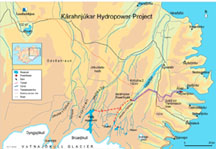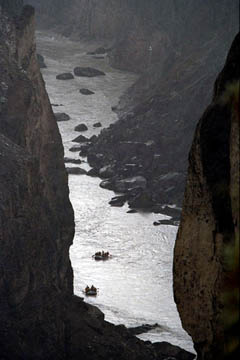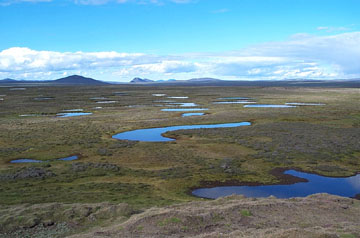Geotimes

Web Extra
Thursday, August 1
Proposed Iceland dam generates
controversy
This summer may prove to be a landmark in Iceland's history as the government
and Alcoa, the world's largest aluminum company, negotiate prices and terms
for constructing and operating Iceland's largest energy project, the Karahnjukar
Hydropower Project.
The project, to be situated north of the Vatnajökull Glacier in an area
claimed as Europe's second largest wilderness area, is the most recent manifestation
of plans that have been debated since the late 1950s to harness the energy of
the area's large glacial meltwater rivers. Recent government support has accelerated
the process, and the project may soon be a reality. Alcoa has signed a Memorandum
of Understanding with the government and Landsvirkjun, the national power company,
to pay three-fourths of the cost of road construction across the wilderness,
and Landsvirkjun hopes to begin construction before this winter. These developments,
along with opposition from environmentalists, have brought the issue to the
forefront in Icelandic news.
 The
present project would dam and divert two of the area's largest rivers, the Jökulsá
á Brú and the Jökulsá í Fljótsdal, and
divert four smaller rivers. The resulting Hálslón reservoir will
submerge 57 square kilometers of isolated highland wilderness. Water from the
reservoir will be transported through a 40-kilometer-long tunnel over to a powerhouse
and from there to the proposed Alcoa aluminum smelter plant in Reyðarfjöður.
This smelter will be the sole user of this energy.
The
present project would dam and divert two of the area's largest rivers, the Jökulsá
á Brú and the Jökulsá í Fljótsdal, and
divert four smaller rivers. The resulting Hálslón reservoir will
submerge 57 square kilometers of isolated highland wilderness. Water from the
reservoir will be transported through a 40-kilometer-long tunnel over to a powerhouse
and from there to the proposed Alcoa aluminum smelter plant in Reyðarfjöður.
This smelter will be the sole user of this energy.
Map of the proposed Karahnjukar Hydropower Project site.
Click on image for detail. Supplied courtesy of Landsvirkjun.
Geologically, Iceland is unique, with both frequently active volcanoes and
extensive glaciers. Geothermal power generates all household energy which represents
10 percent of the total energy produced in the country. Hydroelectric power
accounts for 90 percent of Iceland's supply and is predominant in the industry
sector. "It is still not clear whether the planned Karahnjukar dam is really
the most cost effective way of providing the power needed for the planned Alcoa
smelter," says Olafur S. Andresson, a biochemist at the University of Iceland
and a board member of the largest environmental non-governmental organization,
Icelandic Nature Conservation Association (INCA), the local partner of the World
Wildlife Fund. "It is quite feasible to construct a smaller, lower-impact
dam and reservoir and use readily available geothermal power to supply the plant."
Siggurdur Arnalds, project manager for the Environmental Impact Assessment report
commissioned for the dam and an Honnun Consulting engineer at Landsvirkjun,
disagrees. "There is absolutely no intention by Landsvirkjun to make the
Karahnjukar Project smaller. Many changes have been made in the past and therefore
a considerable amount of energy has already been cut off as environmental compromises.
A further reduction would be a waste of our national resources and is not in
agreement with the Government."
The Environmental Impact Assessment report states that risks from large-scale
volcanic hazards and associated seismicity by the building of the dam are considered
small as most of the active volcanism is west of the proposed site. The hazards
of harnessing glacial rivers are also relatively low in Iceland. Three other
power-intensive plants in Iceland tap glacial meltwaters, and the Alcoa aluminum
plant will be the fourth, Arnalds says.
 Guðmundur
E. Sigvaldason, past director of the Nordic Volcanological Institute in Reykjavik
and geologic advisor to INCA, is more cautious about the geological hazards
of the area and the unique interplay of climate, mantle viscosity and crustal
deformation in the region. "The observed heavy fracturing of the crust
at the dam site combined with ongoing crustal deformation due to fluctuations
in glacier loading is a serious matter of concern for the proposed project,"
Sigvaldason says. He also says that no hazard evaluation has been performed
on a nearby volcano that might have adverse effects on the project. The volcano
is located in a relatively quiescent part of Iceland, but Sigvaldason contends
that the region does not have a well documented dataset of volcanic and seismic
activity. Landsvirkjun and the government have countered Sigvaldason's comments
on the basis of their research. "There is no doubt that the project leaders
are correct when saying that in view of the information they received it is
very unlikely that natural events will damage the construction. The question
remains if the information received was sufficient and correct," says Sigvaldason.
Guðmundur
E. Sigvaldason, past director of the Nordic Volcanological Institute in Reykjavik
and geologic advisor to INCA, is more cautious about the geological hazards
of the area and the unique interplay of climate, mantle viscosity and crustal
deformation in the region. "The observed heavy fracturing of the crust
at the dam site combined with ongoing crustal deformation due to fluctuations
in glacier loading is a serious matter of concern for the proposed project,"
Sigvaldason says. He also says that no hazard evaluation has been performed
on a nearby volcano that might have adverse effects on the project. The volcano
is located in a relatively quiescent part of Iceland, but Sigvaldason contends
that the region does not have a well documented dataset of volcanic and seismic
activity. Landsvirkjun and the government have countered Sigvaldason's comments
on the basis of their research. "There is no doubt that the project leaders
are correct when saying that in view of the information they received it is
very unlikely that natural events will damage the construction. The question
remains if the information received was sufficient and correct," says Sigvaldason.
Looking down into the 160-meter-deepDimmugljúfur
or the Dark Canyon,carved out by the Jökulsá á Brú
river . The canyon will be dammed at its entrance and dry except for the wettest
months of the year. Photo supplied courtesy of INCA.
The ecological and environmental implications are also controversial. Though
not designated as a protected area, except for the reindeer calving grounds
at Kringilsárrani, the region is cited for its unique ecology and geology.
Some of the most intact examples of Iceland's original vegetation survive here.
Dimmugljúfur, the Dark Canyon, a 160-meter-deep canyon carved out by
the Jökulsá á Brú is considered one of Iceland's most
spectacular. Environmentalists claim that the dam would destroy much of this
vegetation and leave the canyon dry. "Below the dams, river flow will greatly
decease during the summer time. On the lowlands, the greatest impact will be
on Lake Lagarfljót (third largest lake in Iceland) and its biology, mainly
wetland areas with rich bird life. Out in the ocean, marine life will be affected
along the coast of Héraðsfloi bay," says Hilmar J. Malmquist,
freshwater biologist, curator of the Natural History Museum of Kópavogur
and INCA board member. Soil erosion, a well known problem in other parts of
Iceland, may also be an issue here. Landsvirkjun counters these claims with
its own assessments.
Despite a history of controversy regarding the environmental soundness of the
project, the government vouches for it on the grounds that it will boost the
economy of northeast Iceland and keep the locals from migrating to larger urban
areas in search of jobs. The dam proposal was rejected by the Iceland Planning
Agency in August 2001 of the grounds that the environmental impact information
was insufficient. However, in December 2001, after Landsvirkjun provided additional
information and modifications to the initial proposal, the environmental minister,
Siv Fridleifsdottir, overruled the Iceland Planning Agency rejection of the
proposal and reinstated it. This April, the plan faced setbacks when Norsk Hydro,
the Norwegian aluminum company originally commissioned as the partner in the
project, backed out citing financial concerns.
 Looking
northeast at the wetlands of the Kringilsárrani Nature Reserve. Kringilsarrani
isa protected reindeer calving area. Part of Kringilsárrani will be submerged
when the Kárahjúkar dam is built. Photo supplied by Guðmundur
Páll Ólafsson.
Looking
northeast at the wetlands of the Kringilsárrani Nature Reserve. Kringilsarrani
isa protected reindeer calving area. Part of Kringilsárrani will be submerged
when the Kárahjúkar dam is built. Photo supplied by Guðmundur
Páll Ólafsson.
Now, with Alcoa as a partner, the government hopes to have the project completed
so that at least 600 permanent jobs and many more temporary ones during the
construction phase are created. "The gross export values from this project
will be the same order of magnitude as the entire foreign income received today
in Iceland through tourism, so the economic value and growth for the country
is very important," Arnalds says.
Environmentalists argue that the project will not boost the Icelandic economy
enough, but would instead harm ecotourism. Tourism is presently Iceland's second
largest source of revenue. Arnalds contends that this area is not one of Iceland's
tourist hotspots. "Due to the high altitude, it is hardly accessible until
very late July each year and is generally less visited than other parts of the
highlands," he says. In addition, he explains that Landsvirkjun and Alcoa
support plans being proposed for a national park at the boundary of the facility
and suggests that the infrastructure for the dam will provide accessibility
to this park.
Depending on who one asks, public popularity for the project varies. "In
an opinion poll made by INCA recently, 65 percent of the nation agreed to have
a national park where the Karahnjukar project is supposed to be built,"
Hilmquist says, acknowledging at the same time that Landsvirkjun polls tell
a different story. "A new Gallup shows that from those who took a position,
61 percent favor the power plant and 73 percent are in favor of the aluminum
plant," Arnalds says.
In late August, when road construction is slated to begin, INCA hopes to re-file
a lawsuit against the minister of environment to nullify her decision to go
ahead with the project. "So there is a good probability that the development
will be delayed and modified," Andresson says, indicating that the Karahnjukar
project will continue to generate controversy before it receives a clean bill
to be built and operate as Iceland's largest source of hydroelectric power.
Salma Monani
Links:
Iceland Nature Conservation Association
(which also has links to other articles on the issue)
Landsvirkjun, National Power Company
New
York Times July 16, 2002 article
 The
present project would dam and divert two of the area's largest rivers, the Jökulsá
á Brú and the Jökulsá í Fljótsdal, and
divert four smaller rivers. The resulting Hálslón reservoir will
submerge 57 square kilometers of isolated highland wilderness. Water from the
reservoir will be transported through a 40-kilometer-long tunnel over to a powerhouse
and from there to the proposed Alcoa aluminum smelter plant in Reyðarfjöður.
This smelter will be the sole user of this energy.
The
present project would dam and divert two of the area's largest rivers, the Jökulsá
á Brú and the Jökulsá í Fljótsdal, and
divert four smaller rivers. The resulting Hálslón reservoir will
submerge 57 square kilometers of isolated highland wilderness. Water from the
reservoir will be transported through a 40-kilometer-long tunnel over to a powerhouse
and from there to the proposed Alcoa aluminum smelter plant in Reyðarfjöður.
This smelter will be the sole user of this energy.
 Guðmundur
E. Sigvaldason, past director of the Nordic Volcanological Institute in Reykjavik
and geologic advisor to INCA, is more cautious about the geological hazards
of the area and the unique interplay of climate, mantle viscosity and crustal
deformation in the region. "The observed heavy fracturing of the crust
at the dam site combined with ongoing crustal deformation due to fluctuations
in glacier loading is a serious matter of concern for the proposed project,"
Sigvaldason says. He also says that no hazard evaluation has been performed
on a nearby volcano that might have adverse effects on the project. The volcano
is located in a relatively quiescent part of Iceland, but Sigvaldason contends
that the region does not have a well documented dataset of volcanic and seismic
activity. Landsvirkjun and the government have countered Sigvaldason's comments
on the basis of their research. "There is no doubt that the project leaders
are correct when saying that in view of the information they received it is
very unlikely that natural events will damage the construction. The question
remains if the information received was sufficient and correct," says Sigvaldason.
Guðmundur
E. Sigvaldason, past director of the Nordic Volcanological Institute in Reykjavik
and geologic advisor to INCA, is more cautious about the geological hazards
of the area and the unique interplay of climate, mantle viscosity and crustal
deformation in the region. "The observed heavy fracturing of the crust
at the dam site combined with ongoing crustal deformation due to fluctuations
in glacier loading is a serious matter of concern for the proposed project,"
Sigvaldason says. He also says that no hazard evaluation has been performed
on a nearby volcano that might have adverse effects on the project. The volcano
is located in a relatively quiescent part of Iceland, but Sigvaldason contends
that the region does not have a well documented dataset of volcanic and seismic
activity. Landsvirkjun and the government have countered Sigvaldason's comments
on the basis of their research. "There is no doubt that the project leaders
are correct when saying that in view of the information they received it is
very unlikely that natural events will damage the construction. The question
remains if the information received was sufficient and correct," says Sigvaldason. Looking
northeast at the wetlands of the Kringilsárrani Nature Reserve. Kringilsarrani
isa protected reindeer calving area. Part of Kringilsárrani will be submerged
when the Kárahjúkar dam is built. Photo supplied by Guðmundur
Páll Ólafsson.
Looking
northeast at the wetlands of the Kringilsárrani Nature Reserve. Kringilsarrani
isa protected reindeer calving area. Part of Kringilsárrani will be submerged
when the Kárahjúkar dam is built. Photo supplied by Guðmundur
Páll Ólafsson.